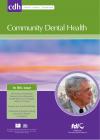Community Dental Health

- Cover Date:
- December 2009
- Print ISSN:
- 0265 539X
- Vol:
- 26
- Issue:
- 4
Book Review - “Food constituents and oral healthâ€
Book Review
“Food constituents and oral health†(ed. Michael Wilson) ISBN: 9781845694180. £150/ US$285/€190 + P&P. Published by Woodhead Publishing.
This 528-page book is a most useful addition to knowledge. The range of people who could learn much from it is wide and will include lecturers, researchers, nutritionists, clinicians, and many in industry concerned with product development. The downside is its cost (GBP 150, Euro 190, USD 285) which will reduce purchase by individuals. The quality of the book is excellent, and the editor and publishers should be congratulated for achieving pretty rapid publication, evidenced by quite a number of 2008 references. The purpose of the book is well put in the Preface as “… to provide a state-of-the-art overview of what is known about the role that the diet and its various constituents play in the oral health of humans and to summarise the ways in which such knowledge may be used, to not only provide new ways of improving oral health, but also to reduce the adverse effects of certain dietary constituents and practicesâ€. There are 24 chapters varying in length from 10 to 40 pages – just right for one chapter a night. These chapters are divided into three parts – ‘The nature of the problem; oral diseases and the impact of nutrition’; ‘Food components and oral health’; ‘Technology and product development’ – with the first chapter in each part providing an overview. The editor – Michael Wilson, Professor of Microbiology at UCL London – has chosen the authors well and, although there are repetitions between chapters, cross-referencing helps to turn this from an annoyance into a virtue. The authors of the chapters are ‘top drawer’, and come from 10 countries. Style of writing varies and some reviews are better than others, but this does not detract from the considerable value of the book. Looking at the book in more detail, one of the strengths of this state of the art summary is the extensive list of references. Sensibly, these are given in a user-friendly format and listed at the end of each chapter. They cover 99 out of the 528 pages, providing some 2,100 references with surprisingly little duplication between chapters. If I was to highlight five chapters, I would chose chapters 10 (Casein phosphopeptides in oral health), 11 (Antioxidants and periodontal disease), 14 (Food, nutrition and oral cancer), 20 (Probiotics and oral health) and 24 (Functional foods and oral health). In addition, the chapter on ‘Alcohol and oral health’ laid out clearly the harmful effects to the mouth, the person and to society. The chapter on ‘Vitamin supplements and oral health’ quite rightly emphasises the harm caused by misuse of supplements, and the much greater value of a healthy diet rather than supplementation. There is a particularly good review of ‘Regulation of functional foods for oral health’ in chapter 24. This discusses the difficult interface between medicines and functional foods, particularly regarding health claims, and provides current (2008) regulations in several countries – information very difficult to obtain. There are a few negatives. Chapter 6 on breath malodour, although a relatively new subject of great commercial interest, could have been cut by two-thirds, and perhaps we are treated to an excess of tea, with over seven pages of references in chapter 19, despite low grade evidence of clinical effect with, it would seem, absence of any RCT. There does not appear to be a discussion of Noma (cancrum oris) which, I thought, caused significant morbidity in several areas of the world. Choking on food, caused by poor dental condition, was also not considered, although it may be underestimated as a cause of death. It might have been considered outside the remit of this book, as might a consideration of obesity which is the number one nutritional problem in many countries: despite being a mammoth subject, an argument for its inclusion is that a major driver of over-eating is taste which is an oral function. In fairness, there was some discussion of this topic in chapters 5 and 18. Very few (<10) spelling errors were noted, all were of no importance although readers should be aware that some information regarding fluoride dosages in milk and salt appear to be incorrect on page 497. In summary, it is a sizeable tome at quite a high price; nevertheless it provides a unique, authoritative and up-to-date review of the very many aspects of the food we eat, and may eat in the future, that affect health and disease and is, therefore, strongly recommended. Andrew Rugg-Gunn
- Article Price
- £15.00
- Institution Article Price
- £
- Page Start
- 196
- Page End
- 196
- Authors
- Andrew Rugg-Gunn
Articles from this issue
- Title
- Pg. Start
- Pg. End
- Evaluation of the direct and diffusion methods for the determination of fluoride content in table salt
- 204
- 210
- Rural Mexican immigrant parents’ interpretation of children’s dental symptoms and decisions to seek treatment
- 216
- 221
- Assessment of HIV/AIDS awareness among 500 patients referred to the Ankara University Faculty of Dentistry
- 222
- 226
- Professional charges not reimbursed to dentists in the US: evidence from Medical Expenditure Panel Survey, 1996.
- 227
- 233
- Quality of life in patients with dental conditions: comparing patients’ and providers’ evaluation
- 234
- 238
